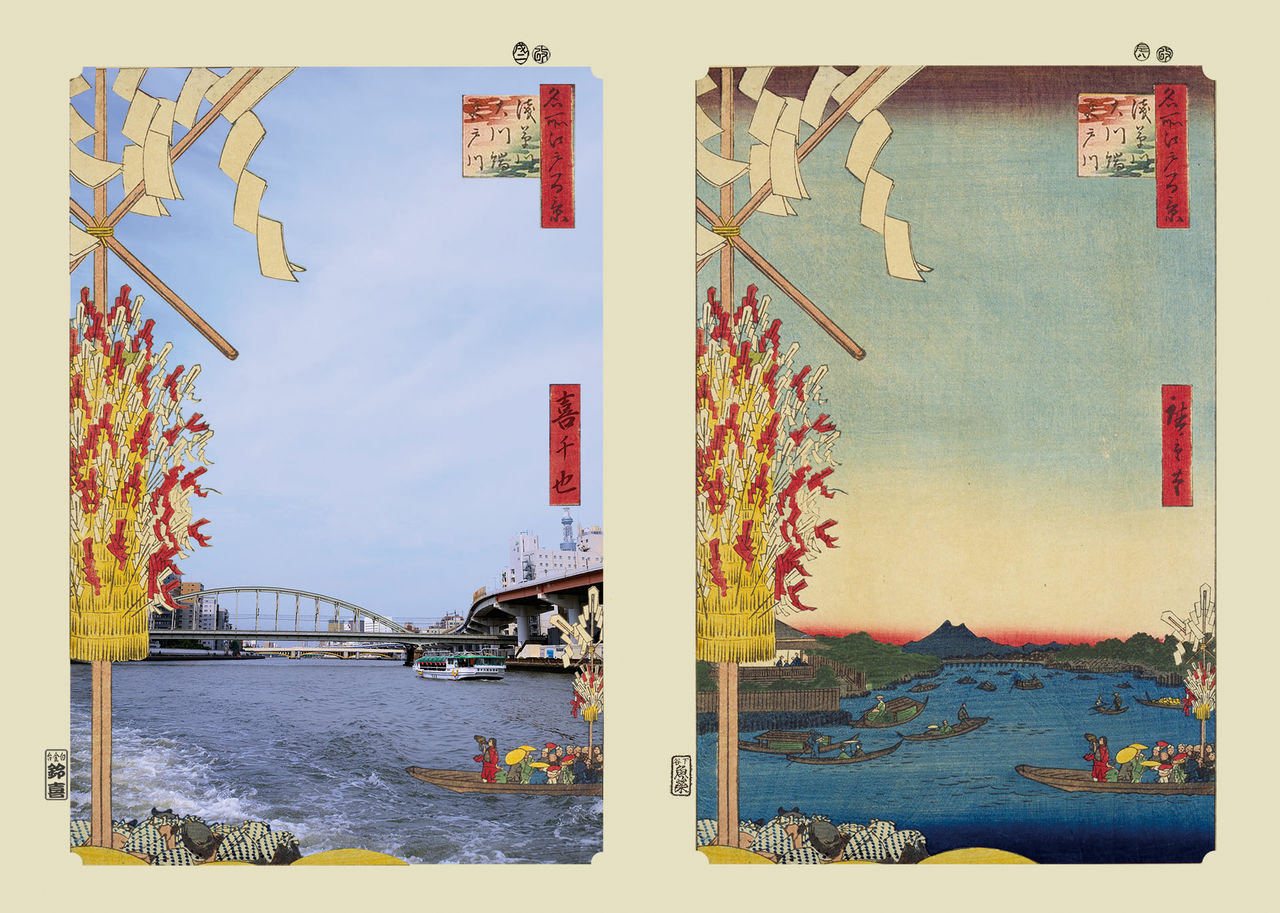
“Asakusa River, Ōkawa Riverbank, Miyato River” : A Once-Bustling Beginning to a Hakone Pilgrimage
Guideto Japan
- English
- 日本語
- 简体字
- 繁體字
- Français
- Español
- العربية
- Русский
Pilgrimage to Mount Ōyama: An Edo Summer Tradition
The three rivers named in the print—Asakusa, Ōkawa, and Miyato—are old names for what today is the Sumida River. The scene shows the river near Ryōgoku bustling with pilgrims setting off on their journey to Mount Ōyama.
The 1,252-meter Mount Ōyama in present-day Kanagawa Prefecture was in Hiroshige’s time a popular summer destination for the religious minded. During the climbing season, which according to the traditional lunar calendar lasted from June 27 to July 17, pilgrims would trudge up the mountain to pay their respects at the Ōyama Afuri Shrine. The deity of the shrine is closely associated with the god enshrined at Hongū Sengen Shrine at Mount Fuji, a connection that gave rise to the ryō-mairi, or dual pilgrimage, popular at the time.
Mount Ōyama stands on the Edo side of the barriers at Hakone, and an Edoite could make the journey in just two or three days without needing to arrange a special travel permit. Although a sacred peak, pilgrims tended to make the trip more for sightseeing than veneration. Women were forbidden from certain parts of the mountain, and pilgrimages became a popular summer outing for all-male groups, particularly those made up of artisans and firefighters.
The custom of the day was to set out from Ryōgoku after performing ritual bathing and purification on the east bank of the river. As Hiroshige’s print shows, this must have made Ryōgoku a very lively place. Depicted in the foreground on the left is a bonten, a huge collection of ceremonial strips of folded paper attached to wooden sticks that are said to have been given out along the road to Mount Ōyama.
I took my photograph from the deck of a water bus. It was during the summer holidays, so even though it was a weekday many families were out on the river sightseeing. It was just like being transported back into the age of crowded summer ferries.
About the Location
Ryōgoku
The area of Ryōgoku is named for Ryōgoku Bridge, the second span to be built across the Sumida River during the Edo period (1603–1868). The name literally means “two provinces,” a reference to the river’s role in marking the border between Musashi province on the west bank and Shimousa on the east.
Today, the neighborhood of Ryōgoku is confined to the east side of the river, but originally it also encompassed the west end of the bridge in what is now Higashi-Nihonbashi. After the Great Fire of Meireki in 1657, a devastating conflagration that consumed large swaths of the city, a wide alley known as Ryōgoku Hirokōji was built at the west end of the bridge to prevent fires from spreading. However, it quickly filled up with vendors offering food, drink, and entertainment in hastily-built, reed-screened sheds and became one of the most popular night spots in Edo.
Today, the west end of Ryōgoku Bridge is an office district, while the east end is home to several landmarks preserving some of the Edo atmosphere, including Buddhist temple Ekōin, the Kokugikan sumō hall, the Edo–Tokyo Museum, and the Sumida Hokusai Museum.
One Hundred Famous Views of Edo by Kichiya, the Ukiyo Photographer: Today’s Tokyo Through Hiroshige’s Eyes
Meisho Edo hyakkei, known in the West as One Hundred Famous Views of Edo, was one of ukiyo-e artist Utagawa Hiroshige’s most celebrated works, influencing even Western artists like Van Gogh and Monet. Drawn in Hiroshige’s final years and published from 1856 to 1861, the series depicted the sights of Edo (as Tokyo was then known) through the changing seasons. Audiences around the world admired Hiroshige’s inventive use of bold compositions, bird’s-eye-view perspectives, and vivid colors. A century and a half later, “ukiyo photographer” Kichiya has set himself the task of recreating each of these views with a photograph taken in the same place, at the same time of year, from the same angle. Join us in this new series at Nippon.com on a tour of these “famous views” in Edo and modern-day Tokyo, guided by Kichiya’s artistry and his knowledge of old maps and life in Edo.
Related Tags
tourism Tokyo ukiyo-e One Hundred Famous Views of Edo by Kichiya Kantō Sumida

